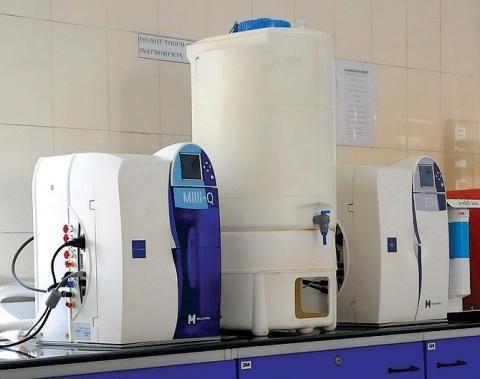Washing and cleaning of laboratory glassware
General rules
1. Always clean your apparatus immediately after each use. It is much easier to clean the glassware before residues in them become dry and hard. If the glassware is dirty and cannot be washed immediately, put it in water to soak.
2. Handle glassware carefully while cleaning it. Most breakage occurs at this time.
3. Quality water produced by water purification system (Fig. 6.4) may be used for laboratory work and rinsing of glassware.
Fig. Water purification system
4. Rinse off all soap or detergent residue after washing glassware to prevent any possible contamination later. Most pieces of laboratory glassware can be cleaned by washing and brushing with a detergent or a special laboratory cleaning product called alconox, teepol, lab wash, lab clean etc. After they have been thoroughly cleaned, they are rinsed with tap water and finally with deionised water. If the surface is clean, the water will wet the surface uniformly. On soiled glass the water stands in droplets.
Cleaning volumetric glassware
1. Always rinse volumetric glassware three times with deionised water after you have emptied and drained it. This prevents solutions from drying on the glassware, causing difficulty in cleaning.
2. Dry volumetric glassware at room temperature, never in a hot oven. Expansion and contraction may change the calibration.
3. The glass surface should wet evenly. Sporting is caused by grease and dirt.
4. Removing grease: Rinse and scrub with hot detergent solution followed by adequate deionised water rinses. Removing dirt: Fill or rinse with an acid solution. Allow to stand for several hours, if necessary. Follow with multiple deionised water rinses.
Cleaning pipettes
Pipettes may be cleaned with a warm solution of detergent or with cleaning solution. Draw in sufficient liquid to fill the bulb to about one-third of its capacity. While holding it nearly horizontal, carefully rotate the pipette so that all interior surfaces are covered. Drain inverted and rinse thoroughly with deionised water. Inspect for water breaks and repeat the cleaning cycle as often as necessary.
Cleaning burettes
Thoroughly clean the tube with detergent and a long brush. Allow the washings to exit through the burette tip.
Chromic acid wash
Follow all normal safety precautions when using concentrated acids and acid solutions. Acids can severely burn the skin. Dispose of all acids properly. A chromic acid wash has hydrolytic and oxidative capabilities for the chemical decomposition of biological molecules. The acid may also dissolve mineral deposits. To prepare a chromic acid wash, mix 20 g of sodium or potassium chromate with sufficient distilled water to make a paste of chromate salt. Add 300 ml of concentrated sulfuric acid. Increase the proportions to make larger amounts. Use the mixture until it turns green in color. It may be necessary to let heavily soiled items soak overnight.
Mineral deposits
Soak glassware in concentrated sulfuric, hydrochloric or nitric acid. Follow all precautions for the handling of these solutions. Hydrochloric acid diluted to 1 M in water is often used to remove mineral scales built up in water. Nitric acid is useful for cleaning stainless steel and removing rust strains.

